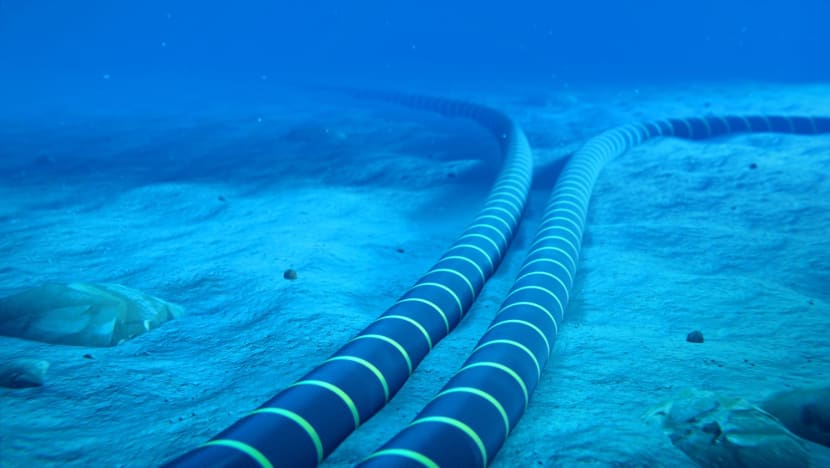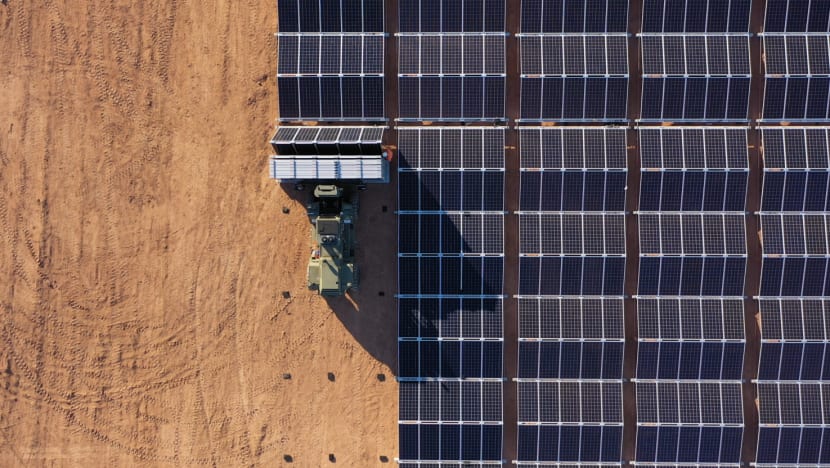Singapore-based Sun Cable collapses, stalling Australia-to-Asia solar power project
 |
| A 4,200km undersea cable promises to deliver vast amounts of clean energy to Singapore. (Image: Sun Cable) |
11 Jan 2023
Singapore-based Sun Cable is going into voluntary administration, the clean energy firm said on Wednesday (Jan 11), months after billionaire Mike Cannon-Brookes took on the role of chairman.
The company is aiming to develop a A$30 billion-plus (S$27.6 billion) project to supply solar power from Australia to Singapore, with the backing of tech billionaire and climate activist Cannon-Brookes and the richest man Down Under Andrew Forrest...
Snap Insight: What Sun Cable collapse means for Singapore’s plans to diversify energy sources
Sun Cable’s move into voluntary administration makes the fate of an ambitious Australia-to-Singapore solar project uncertain, but all is not lost yet, says the Energy Studies Institute’s David Broadstock.
 |
| What makes PowerLink a particularly attractive proposition is that Australia has the resources to deploy large-scale solar farms, from which Asian countries would be able to import large quantities of green electricity. (Image: Sun Cable) |
David Broadstock
11 Jan 2023
11 Jan 2023
SINGAPORE: The PowerLink had been hyped as an ambitious infrastructure project, helmed by Singapore-based start-up Sun Cable, which would supply Singapore and Indonesia with solar energy from Australia.
Stretching across 4,200km, it would be the world’s longest undersea cable carrying up to 3.2GW of electricity – under half of Singapore’s peak electricity demand today. The project was slated to begin construction in 2024 and become operational by 2029.
News on Wednesday (Jan 11) that Sun Cable is going into voluntary administration, making the fate of the PowerLink uncertain, might be disappointing for clean energy advocates.
What makes PowerLink a particularly attractive proposition is that Australia has the resources to deploy large-scale solar farms, from which Asian countries would be able to import large quantities of green electricity. This is very attractive for Singapore where there is a lack of land for solar or other renewable energy generation.
An obvious question is whether this is a bad start for Singapore’s plans to import clean energy from regional partners. The country has a target of importing 4GW of low-carbon electricity by 2035, or 30 per cent of projected electricity supply then.
ALL IS NOT LOST
Sun Cable’s collapse is certainly not a step in the right direction, but all is not lost just yet.
 |
| The 4,200km undersea cable was to deliver vast amounts of clean energy to Singapore. (Image: Sun Cable) |
Sun Cable’s move into voluntary administration results from two major backers being unable to agree on the future direction and funding structure of the company.
This is a critical blow to Sun Cable’s business, but it is too early to say all options are fully exhausted. Already there is emerging discussion that Squadron Energy, one of Sun Cable’s two backers, may consider putting together a separate funding deal.
The devil will be in the details. Why were Sun Cable’s two main stakeholders unable to reach mutually agreeable terms over a project pipeline of strategic regional importance? Was it a matter of clashing personalities, or were there larger questions about financial viability?
Those were two reasons alluded to by Sun Cable in their statement on Wednesday. The fact that both were put forward leaves some ambiguity. Speculating over the details behind Wednesday’s news may be best avoided until additional details emerge.
An unambiguous truth though is that Sun Cable would have been very reluctant to go into administration. Moreover, if the financial proposition makes commercial sense, differences in strategic vision and direction are easier to resolve.
REGIONAL POWER GRIDS STILL CRITICAL FOR SINGAPORE
Sun Cable’s move into administration does not alter why regional grid connections are important for Singapore.
While Singapore remains on track to meet its imports target of 4GW by 2035, it needs more diversity in its energy sources, as this helps build energy resilience. Moves to set up energy trade with Malaysia and Laos not only contributes to this effort, but also creates economic gains for neighbouring countries with clean energy resources.
In the grand scheme of things, if infrastructure such as PowerLink remains of critical importance and is a viable commercial opportunity, it will be developed. These events may create some delay, but perhaps not enough to derail Singapore’s decarbonisation ambitions.
Questions will need to be asked and lessons learned for ongoing renewable energy sharing projects, especially regional green power grids.
This might involve investigations into how the global energy crunch, recession fears and other contextual factors may have made a mega-project such as PowerLink become a commercial risk, and how governments and financial institutions may be able to react.
David Broadstock is Senior Research Fellow at Energy Studies Institute, National University of Singapore.
Source: CNA/el
What we know about Sun Cable and its collapsed Australia-Singapore solar energy project
Sun Cable's flagship project planned to harness solar energy in Australia and transmit it to Singapore for use.
Abigail Ng
13 Jan 2023
SINGAPORE: Renewable energy firm Sun Cable said on Wednesday (Jan 12) that it will enter voluntary administration after the company's backers failed to reach an agreement on funding structure and what direction it should take.
Voluntary administration refers to a process where a company's directors appoint independent administrators to step in to find a path forward for the business, which is usually facing financial difficulties.
Here's what we know about Sun Cable:
What does the company do?
Sun Cable is the company behind a A$30 billion (S$27.5 billion) project known as the Australia-Asia PowerLink, which had planned to channel solar energy from Australia to the Asia-Pacific region.The company said it would capture solar energy in Australia's Northern Territory and transmit it to be used in Darwin, which is also in the Northern Territory, as well as in Singapore.
It intended to begin construction on the 4,200km undersea cable in 2024 and be fully operational in 2029. Sun Cable claimed it could carry 3.2GW of electricity and supply up to 15 per cent of Singapore's total electricity needs.
The company, which was founded in 2018, has offices in Singapore, Jakarta and multiple cities in Australia.
Why did it enter administration?
In Sun Cable's case, it did receive funding proposals, but “consensus on the future direction and funding structure of the company could not be achieved”, according to a press release.“The voluntary administration process will now unlock a path forward for the company to access additional capital for continued development of its (marquee) project,” the statement said.
“The administrators intend to work with the company’s management team and key stakeholders to determine appropriate next steps for the business.
“This will likely involve a process to seek expressions of interest for either a recapitalisation or sale of business.”
Who are its investors?
Major investors include private investment company Grok Ventures and Australia's Squadron Energy, but Sun Cable has also raised money from other private investors.In March 2022, Sun Cable said it raised A$210 million. However, not all the funds were made available to the company because it had not met some milestones, Reuters reported.
Billionaire and climate activist Mike Cannon-Brookes, who was principal investor at Grok Ventures, took over as chairman of Sun Cable last year. Grok Ventures has invested in a range of businesses including technology and clean energy firms, as well as graphic design platform Canva.
Squadron Energy is owned by Tattarang, a holding company for the family of Australian billionaire Andrew Forrest. Mr Forrest is chairman of iron ore giant Fortescue Metals.
What does this mean for Sun Cable's flagship project?
Squadron Energy may put together a funding deal for the administrators, Reuters reported, citing a person familiar with the company’s thinking.Squadron Energy chairman John Hartman told Reuters it believes in Sun Cable's vision, but that "the manner in which the project is delivered needs urgent change".
"Exceptional governance practices and world-class project delivery expertise, as well as pursuing bankable technologies, will be required to make the project a reality," he said.
Australia's Energy Minister Chris Bowen told reporters: "I remain very upbeat and excited about Sun Cable's future."
He said he spoke to "very senior people" in the company.
What is Singapore's involvement?
Second Minister for Trade and Industry Tan See Leng in January 2021 said there were ongoing discussions on Sun Cable's proposal to supply solar power to Singapore. Dr Tan said the Energy Market Authority could not share more details due to "commercial sensitivities".Sun Cable asked Surbana Jurong member company SMEC to provide engineering consulting services for solar generation systems and grid connection interfaces in Australia, CNA reported in October 2021.
Surbana Jurong said it was facilitating the "early works" of the project, including "mapping out the regulatory approvals required to tie Sun Cable’s solution into the Singapore grid as well as providing technical services for receiving infrastructure such as voltage source converters, substations and subsea cables for landing the power in Singapore".
What will happen to Singapore staff?
Sun Cable’s subsidiary in Singapore is not in administration. Staff will remain employed. However, since the parent entity in Australia is in administration, Singapore employees may be affected in future.Source: CNA/an(cy)
[Notes:
Why can't we put solar panels on all our roofs?
Sure. You were the first person to think of it. Brilliant. Not like our million dollar ministers and hundred thousand dollars civil servants who haven't thought of it!
Here are some facts - the proposed solar farm in Australia (the Sun Cable project) is to be 120,000 hectares. This is 120 sq km. And this will provide 15% - 20% of Singapore's electrical energy needs.
IF Singapore were as sunny as the Australian desert, we could cover 600 sq km of our island and have almost 100% solar powered Singapore! Or maybe 720 - 840 sq km (if the Sun Cable solar farm only provides closer to 15% of our needs.) Guess how large is Singapore island? 720 sq km.
What is the total amount of rooftop area that we can use for solar? 13.2 sq km. If 120 sq km gives us 15 - 20% of our needs. 13.2 sq km will probably give us about 2% of our needs. Installing solar on our building facades (vertical solar panels) - we have less than 10 sq km of usable space.
And while sunny Singapore seems to be very sunny, we are NOT as sunny as the Australian desert, so the same solar panels in Singapore, would not have as much output as the same panel in the desert.]
No comments:
Post a Comment